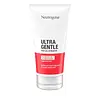What's inside
What's inside
 Key Ingredients
Key Ingredients

No key ingredients
 Benefits
Benefits

 Concerns
Concerns

 Ingredients Side-by-side
Ingredients Side-by-side

Water
Skin ConditioningGlycerin
HumectantDimethicone
EmollientNiacinamide
SmoothingZea Mays Starch
AbsorbentPanthenol
Skin ConditioningPolyacrylamide
Cetearyl Olivate
Phenoxyethanol
PreservativeC13-14 Isoparaffin
EmollientSorbitan Olivate
EmulsifyingCaprylyl Glycol
EmollientEthylhexylglycerin
Skin ConditioningDimethicone Crosspolymer
Emulsion StabilisingCarbomer
Emulsion StabilisingLaureth-7
EmulsifyingSodium Hydroxide
BufferingWater
Skin ConditioningDimethicone
EmollientGlycerin
HumectantPanthenol
Skin ConditioningHexylene Glycol
EmulsifyingPhenoxyethanol
PreservativeCarbomer
Emulsion StabilisingSodium Hydroxide
BufferingPentylene Glycol
Skin ConditioningDisodium EDTA
Propylene Glycol
HumectantEthylhexylglycerin
Skin ConditioningAloe Barbadensis Extract
Skin Conditioning4-T-Butylcyclohexanol
MaskingPEG-40 Hydrogenated Castor Oil
EmulsifyingTrideceth-9
EmulsifyingCitric Acid
BufferingHydroxyphenyl Propamidobenzoic Acid
Skin ConditioningLavandula Angustifolia Flower/Leaf/Stem Extract
MaskingBisabolol
MaskingWater, Dimethicone, Glycerin, Panthenol, Hexylene Glycol, Phenoxyethanol, Carbomer, Sodium Hydroxide, Pentylene Glycol, Disodium EDTA, Propylene Glycol, Ethylhexylglycerin, Aloe Barbadensis Extract, 4-T-Butylcyclohexanol, PEG-40 Hydrogenated Castor Oil, Trideceth-9, Citric Acid, Hydroxyphenyl Propamidobenzoic Acid, Lavandula Angustifolia Flower/Leaf/Stem Extract, Bisabolol
 Reviews
Reviews

Ingredients Explained
These ingredients are found in both products.
Ingredients higher up in an ingredient list are typically present in a larger amount.
Carbomer is a polymer of acrylic acid. Its main role is to create a gel consistency.
A high amount of carbomer can cause pilling or balling up of products. Don't worry, most products contain 1% or less of carbomer.
Dimethicone is a type of synthetic silicone created from natural materials such as quartz.
What it does:
Dimethicone comes in different viscosities:
Depending on the viscosity, dimethicone has different properties.
Ingredients lists don't always show which type is used, so we recommend reaching out to the brand if you have questions about the viscosity.
This ingredient is unlikely to cause irritation because it does not get absorbed into skin. However, people with silicone allergies should be careful about using this ingredient.
Note: Dimethicone may contribute to pilling. This is because it is not oil or water soluble, so pilling may occur when layered with products. When mixed with heavy oils in a formula, the outcome is also quite greasy.
Learn more about DimethiconeEthylhexylglycerin (we can't pronounce this either) is commonly used as a preservative and skin softener. It is derived from glyceryl.
You might see Ethylhexylglycerin often paired with other preservatives such as phenoxyethanol. Ethylhexylglycerin has been found to increase the effectiveness of these other preservatives.
Glycerin is already naturally found in your skin. It helps moisturize and protect your skin.
A study from 2016 found glycerin to be more effective as a humectant than AHAs and hyaluronic acid.
As a humectant, it helps the skin stay hydrated by pulling moisture to your skin. The low molecular weight of glycerin allows it to pull moisture into the deeper layers of your skin.
Hydrated skin improves your skin barrier; Your skin barrier helps protect against irritants and bacteria.
Glycerin has also been found to have antimicrobial and antiviral properties. Due to these properties, glycerin is often used in wound and burn treatments.
In cosmetics, glycerin is usually derived from plants such as soybean or palm. However, it can also be sourced from animals, such as tallow or animal fat.
This ingredient is organic, colorless, odorless, and non-toxic.
Glycerin is the name for this ingredient in American English. British English uses Glycerol/Glycerine.
Learn more about GlycerinPanthenol is a common ingredient that helps hydrate and soothe the skin. It is found naturally in our skin and hair.
There are two forms of panthenol: D and L.
D-panthenol is also known as dexpanthenol. Most cosmetics use dexpanthenol or a mixture of D and L-panthenol.
Panthenol is famous due to its ability to go deeper into the skin's layers. Using this ingredient has numerous pros (and no cons):
Like hyaluronic acid, panthenol is a humectant. Humectants are able to bind and hold large amounts of water to keep skin hydrated.
This ingredient works well for wound healing. It works by increasing tissue in the wound and helps close open wounds.
Once oxidized, panthenol converts to pantothenic acid. Panthothenic acid is found in all living cells.
This ingredient is also referred to as pro-vitamin B5.
Learn more about PanthenolPhenoxyethanol is a preservative that has germicide, antimicrobial, and aromatic properties. Studies show that phenoxyethanol can prevent microbial growth. By itself, it has a scent that is similar to that of a rose.
It's often used in formulations along with Caprylyl Glycol to preserve the shelf life of products.
Sodium Hydroxide is also known as lye or caustic soda. It is used to adjust the pH of products; many ingredients require a specific pH to be effective.
In small amounts, sodium hydroxide is considered safe to use. However, large amounts may cause chemical burns due to its high alkaline.
Your skin has a natural pH and acid mantle. This acid mantle helps prevent harmful bacteria from breaking through. The acid mantle also helps keep your skin hydrated.
"Alkaline" refers to a high pH level. A low pH level would be considered acidic.
Learn more about Sodium HydroxideWater. It's the most common cosmetic ingredient of all. You'll usually see it at the top of ingredient lists, meaning that it makes up the largest part of the product.
So why is it so popular? Water most often acts as a solvent - this means that it helps dissolve other ingredients into the formulation.
You'll also recognize water as that liquid we all need to stay alive. If you see this, drink a glass of water. Stay hydrated!
Learn more about Water